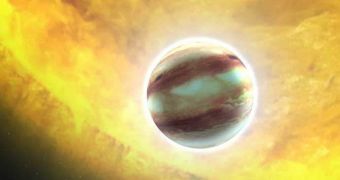An international collaboration of scientists was recently able to figure out how massive gas giant extrasolar planets around distant stars avoid plunging into their parent stars, and meeting a fiery end.
Orbital drifts are a common occurrence around other stars, astronomers say. Due to the relatively-low number of rocky inner planets, gas giants the size of Jupiter and Saturn form farther out around their parent stars, and then move inward at speed. Sometimes, this course plunges them into their suns.
The solar system is somewhat atypical as far as planetary arrangements go. The first four planets from the Sun are small, rocky worlds, followed by two gas giants and two ice giants. In other systems, it is far more likely to discover gas giants orbiting very close to their parent stars, occupying a short orbit similar to Mercury's (which takes 88 days to spin around the Sun).
In a paper published in the November 20 issue of the esteemed Astrophysical Journal, experts at the McMaster University, in Canada, reveal the existence of so-called planetary traps, which apparently prevent the inward migration of gas giants from leading them to their deaths.
These traps are usually located in the gassy, dusty disks surrounding these stars. The finding goes a long way towards explaining the existence of hot Jupiters, planets the size of gas giants in our solar system that should have fallen into their parent stars long ago, but did not.
“In the calculations, the entire history of how planets grow and migrate in the disks is computed using simple 'recipes. They showed that, without the slowing down of Type I migration artificially, the population of gas giants cannot be generated,” MMU expert Yasuhiro Hasegawa told Space.
Experts say that the planet traps form when the temperature and density of the debris disk around stars changes suddenly. This is enough to significantly slow down Type I migrations, though they do not stop the spiraling exoplanets completely. The traps themselves were found to move closer to the stars at a slow pace.
“Once the mass of the cores is large enough – roughly larger than 10 Earth-masses – and a gap is opened in the disk, then the cores will drop out from their traps,” Hasegawa explains. He led the new research with study coauthor Ralph Pudritz, who is also based at McMaster University.
“Since super-Earths and hot Neptunes are low-mass planets, they cannot go into the gas accretion. In other words, they are 'failed' gas giants,” the investigator concludes.

 14 DAY TRIAL //
14 DAY TRIAL //